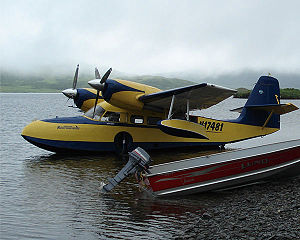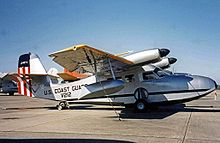Grumman Widgeon Video - Landing
|
|
Grumman Widgeon
G-44 Widgeon

Picture - A Grumman Widgeon on Frazier Lake on the southwest end of Kodiak Island, Alaska
Role: Amphibious transport
Manufacturer: Grumman
First flight: 1940
Primary users: United States Navy
United States Army Air Force
United States Coast Guard
Royal Navy
Number built: 317 (including license built French SCAN 30)
The Grumman G-44 Widgeon is a small, five-person, twin-engine amphibious aircraft. (See FAA Type Certificate Number A-734; aircraft is designated a "5 PCL-Am-FbM" which means it is a 5-place Cabin Landplane-Amphibian-Flying Boat Monoplane.) It was designated J4F by the United States Navy and Coast Guard and OA-14 by the United States Army Air Corps and United States Army Air Forces.
Design and development
The Widgeon was originally designed for the civil market. It is smaller but otherwise similar to Grumman's earlier G-21 Goose, and was produced from 1941 to 1955. The aircraft was used during World War II as a small patrol and utility machine by the United States Navy, US Coast Guard and by the Royal Navy.
The first prototype flew in 1940, and the first production aircraft went to the United States Navy as an anti-submarine aircraft. In total, 276 were built by Grumman, including 176 for the military. During World War II, they served with the US Navy, Coast Guard, Civil Air Patrol and Army Air Force, as well as with the British Royal Navy, who called it the Gosling.
Operational history

Picture - Grumman J4F-1 of the United States Coast Guard preserved at the National Museum of Naval Aviation at Pensacola, Florida in 2002
On August 1, 1942, a J4F-1 flown by US Coast Guard Patrol Squadron 212 based out of Houma, Louisiana and flown by Chief Aviation Pilot Henry White spotted and attacked a German U-boat off the coast of Louisiana. White reported the submarine sunk, and he was subsequently credited with sinking U-166 and awarded the Distinguished Flying Cross.
However, the wreck of U-166 was found sitting near the wreck of SS Robert E. Lee in June 2001 by an oil exploration team working for BP Amoco and Shell Oil Company. The sinking of U-166 on July 30 (that is two days before the Widgeon flight) is now credited to PC-556 patrol craft escorting the Robert E. Lee.
White's Widgeon is now thought to have made an unsuccessful attack against U-171, a Type IXC U-boat identical to U-166 that reported an air attack coincident with White's attack. U-171 was undamaged by White's attack, but was sunk four months later in the Bay of Biscay.
Postwar operations
After the war, Grumman redesigned the aircraft to make it more suitable for civilian operations. A new hull improved its water handling, and six seats were added. A total of 76 of the new G-44A were built by Grumman, the last being delivered on January 13, 1949. Another 41 were produced under licence by the Societe de Construction Aero-Navale (SCAN) in La Rochelle, France as the SCAN-30. Most of these ended up in the United States.
McKinnon Enterprises at Sandy, Oregon converted over 70 Widgeons to "Super Widgeons." The conversion features replacing the engines with 270 hp (201 kW) Avco Lycoming GO-480-B1D flat six piston engines, and various other modifications, including modern avionics, 3-bladed propellers, larger windows, improved soundproofing, emergency exits, and increased Maximum Takeoff Weight. Retractable wing-tip floats are optional.
Variants
G-44
Main production variant, 200 built including military variants listed below.
G-44A
Improved post-war production variant with redesigned hull, 76 built.
J4F-1
G-44 for the United States Coast Guard with three seats, 25 built.
J4F-2
United States Navy version of the J4F-1 with 5-seat interior, 131 built.
OA-14
Fifteen G-44s impressed into wartime service with the United States Army Air Force.
OA-14A
One new aircraft for the Corps of Engineers.
Gosling I
Fifteen J4F-2s transferred to the Royal Navy, later renamed Widgeon I
SCAN 30
G-44 Licence-built in France, 41 built.
Operators
Military operators
Brazil Israel
Israeli Air Force
Portugal Thailand United Kingdom
Royal Navy
United States
United States Army Air Corps
United States Army Air Forces
United States Coast Guard
United States Navy
Civil Air Patrol
Uruguay
Civil operators
New Zealand
Mount Cook Airline
Survivors
Many Widgeons survive in private hands, in various states of restoration or storage. The aircraft continues to enjoy a considerable degree of popularity as a seaplane with many still being flown regularly, though rarely on the warbird circuit.
G-44 (reg. # CF-ODR) is on display at the Canadian Warplane Heritage Museum in Hamilton, Ontario.
G-44 (N13122) is on display at the Alaska Aviation Heritage Museum in Anchorage, Alaska.
Several G-44 are on display at museums in Portugal and France.
G-44A (cn 1449) on display at Royal Thai Air Force Museum, Don Muang AFB.
Ze plane! Ze plane! is a Grumman Widgeon (N4453) seen in the opening scenes of the television series Fantasy Island delivering guests to the island. Though it has a checkered past including drug smuggling and a provenance that includes Richard Bach, it survives in the collection of an antique dealer in Hollister, Missouri and is hangared at M. Graham Clark Field, Taney County Airport.
Specifications (G-44A)
Data from {name of first source}
General characteristics
Crew: one, pilot
Capacity: 5 passengers
Length: 31 ft 1 in (9.47 m)
Wingspan: 40 ft 0 in (12.19 m)
Height: 11 ft 5 in (3.48 m)
Wing area: 245 ft² (22.8 m²)
Empty weight: 3,189 lb (1,470 kg)
Loaded weight: 4,500 lb (2,041 kg)
Max takeoff weight: 4,500 lb (2,500 kg)
Powerplant: 2x— Ranger L-440C-5 inverted inline 6-cylinder engines, 200 hp (150 kW) each
Performance
Maximum speed: 139 kn (160 mph, 257 km/h)
Range: 800 nmi (920 mi, 1,481 km)
Rate of climb: 1,000 ft/min (305 m/min)
Related development
Grumman Goose
Comparable aircraft
Grumman G-21 Goose
Sikorsky S-38
Sikorsky S-39
Piaggio P-136
Supermarine Walrus
Bibliography
Donald, David. The Complete Encyclopedia of World Aircraft. New York: Barnes & Noble Books, 1997. ISBN 0-7607-0592-5.
Taylor, John W. R. Jane's All The World's Aircraft 1976-77. London: Jane's Yearbooks, 1976. ISBN 0-354-00538-3.
Grumman Widgeon Pictures and Grumman Widgeon for Sale.
Living Warbirds: The best warbirds DVD series.
Source: WikiPedia